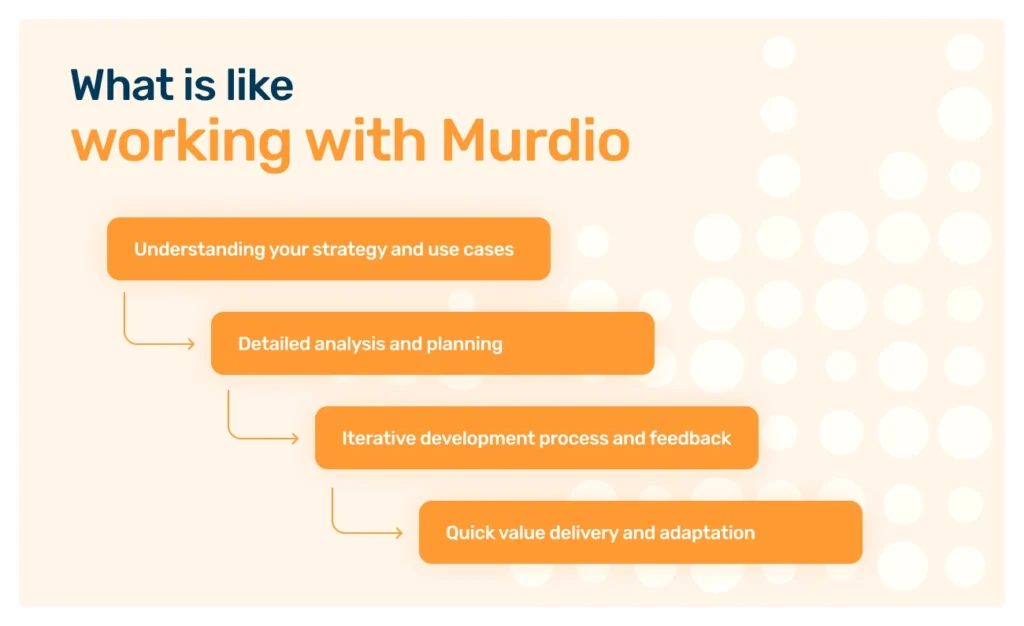At Murdio, we help companies get the most from their data ecosystems, and this topic comes up constantly – because it’s at the very core of what we do and what our clients need. So we’re breaking it down: what data catalogs and metadata management actually are, how they’ve evolved in 2025, and most importantly, how you can make them work together without creating a tangled mess of tools and processes.
Understanding the fundamentals
What is a data catalog, and how does it work?
We’ve talked about data catalogs at length before, so for more elaborate definitions, you can check out some of our previous articles like this one.
But for the purposes of this piece, think of a data catalog like a library system for all your organization’s data. It helps you find what you need, understand what it is, and trust that it’s the right thing to use. Behind the scenes, it indexes data assets, classifies them, and makes them searchable and user-friendly.
A modern data catalog typically includes:
- Automated data discovery so you’re not hunting through systems manually
- Search and indexing to surface relevant data assets fast
- Lineage and usage tracking to see where data came from and how it’s used
- Business glossaries and tagging for shared understanding across teams
- Collaboration tools like comments and ratings to keep knowledge flowing
A solid data catalog can transform how teams interact with data, especially when it’s easy to use and ties into your existing workflows, which really is essential.
Most of all, it democratizes access to data for anyone within the company, regardless of their technical proficiency. And that’s something we see pretty much on a daily basis.
The evolution of data catalogs in 2025
Data catalogs have changed considerably over the past few years, as expected with the rapid growth of AI and machine learning. In 2025, data catalogs are smarter, faster, and more integrated. This is how Forrester’s Wave report for Enterprise Data Catalogs, Q3 2024, talks about this change:
Enterprise data catalogs (EDCs) are witnessing a transformation driven by AI advancements, fragmented and complex data estates, accessibility needs, and strategic imperatives to harness data for competitive advantage. This market is evolving and becoming indispensable for enterprises to leverage their data and AI assets effectively.
In other words, if your experience with data catalogs is still stuck in 2020 (even though it doesn’t seem that long ago, does it?), here are some things that have changed and new benefits that you might expect:
- AI-driven enrichment: Machine learning does the heavy lifting: tagging, classifying, and surfacing relevant insights without constant manual input.
- Real-time updates: Data catalogs now reflect changes in data sources almost instantly, keeping everything fresh.
- Quality indicators: Integration with data quality tools means users get insights into the health of a dataset right in the data catalog.
- User-friendly interfaces: Data catalogs aren’t just for data teams anymore. Business users can dive in without needing a data dictionary to translate.
- Built-in policy awareness: Governance and compliance rules are now embedded, helping organizations stay on the right side of regulations.
All of this and more makes today’s data catalogs even more usable and more reliable.
Defining metadata management in today’s data landscape
Metadata management is the behind-the-scenes magic that keeps your data ecosystem running smoothly. It’s the process of collecting, governing, and maintaining all the information about your data – how it’s structured, where it lives, who owns it, and how it’s being used.
Here’s a quick breakdown of the types of metadata you’re dealing with:
- Technical metadata: Schema, tables, formats, APIs. Think of this as the structural blueprint.
- Business metadata: Definitions, classifications, ownership. This is where data meets the business.
- Operational metadata: Usage logs, transformation history, lineage – all the activity data that tells the story of your data in motion.
Why does it matter? Because without strong metadata management, your data loses meaning and trust. You can’t govern it, secure it, or use it effectively. At Murdio, we often help clients centralize and streamline their metadata practices as a foundation for larger data governance and analytics initiatives that rely on them.
Why are data catalogs and metadata management critical for large enterprises?
If your enterprise is juggling hundreds or thousands of data sources, trying to operate without a clear understanding of your data landscape is a recipe for chaos.
- Data catalogs make your data discoverable, usable, and collaborative. They help people find what they need without sending five Slack messages or digging through undocumented SQL scripts.
- Metadata management helps make sure that what they find is accurate, up-to-date, and compliant with policies.
Together, they help you:
- Improve data literacy
- Reduce data duplication and waste
- Strengthen compliance
- Make better decisions faster
Our take? Both are essential if you want your data to actually work for you, not the other way around. And really, there’s no one without the other, as metadata management is the backbone of a data catalog.
Key differences between data catalogs and metadata management
Core purposes: data catalogs vs. metadata management
Let’s simplify it:
- Data catalogs are software tools for finding and using data with the help of its metadata.
- Metadata management is an approach to governing and maintaining metadata.
And here’s a side-by-side breakdown of the scope and purpose of each:

Primary functionalities that set them apart
Since one is a tool and the other is more of a mechanism, it’s somewhat of an apples-to-oranges comparison. But here’s how it might be dialed down into a handy table:

Tip: Don’t expect your data catalog to manage metadata at scale – it’s excellent at surfacing and displaying it, but the heavy-duty, behind-the-scenes governance belongs to metadata management.
Typical users and stakeholders for each solution
Another way to look at it is by who’s using what:
- Data catalog users:
- Data analysts and scientists
- Business users and product teams
- Anyone searching for trustworthy data to work with
- Metadata management users:
- Data engineers
- IT and compliance teams
- Governance leads and data stewards
If you’re building a data-driven culture, you’ll need both sides working in sync.

Making metadata management and data catalogs work together
Step-by-step implementation guide
Getting these tools to play nicely together takes some planning (and we can help select and implement the right tools).
Here’s a framework we often recommend to clients:
- Audit your current data landscape
Where’s your data stored? Who’s using it? What’s missing? - Define your metadata strategy
What metadata do you need to manage? What are your main goals – compliance, discoverability, quality? - Pick the right tools (and make sure they integrate)
Choose a metadata platform that can connect to your data catalog, and vice versa. Avoid vendor lock-in if possible. - Automate as much as possible
Use crawlers and AI tools to extract metadata, tag assets, and detect anomalies. - Roll out the data catalog as your discovery layer
Make it easy for users to search, filter, and explore with confidence. - Establish governance and stewardship
Assign roles. Set policies. Review regularly. This isn’t a “set it and forget it” situation.
Common pitfalls to avoid
Based on our experience working across over 60 client projects so far, here are a few common things we’d recommend avoiding:
- Treating the data catalog as a metadata repositoryIt might be tempting to think of your data catalog as a one-stop shop for all things metadata, but that’s not its role. A data catalog displays metadata, but it doesn’t manage or govern it. Without a robust metadata management system behind it, your data catalog becomes a beautiful facade with no foundation.
- Overlooking compliance and governanceThis is especially critical in regulated industries. Metadata management enables data traceability, access control, and policy enforcement. If you rely solely on a data catalog, you’re missing the system of record that makes compliance audits painless (or at least less painful).
- Skipping user trainingYou can implement the best tools in the world, but if your teams don’t know how (or why) to use them, they’ll fall back to old habits. We always stress the importance of onboarding, contextual help, and ongoing training to foster adoption. Your data catalog and metadata tools should feel like helpful coworkers, not chores.
- Doing everything manuallyThis probably doesn’t need further explanation. Manual tagging and curation don’t scale.
- Ignoring ongoing maintenanceMetadata gets outdated fast. Businesses change. Systems change. Data changes. If you’re not reviewing and updating your metadata regularly, you’ll end up with outdated entries, broken lineage, and decreased trust.So, set up regular metadata audits and cleanup processes. We can also help build these right into your operating model.
Get experts on board
At Murdio, we guide clients through this process step by step, so that they can apply best practices and avoid common mistakes.
Here’s what working with us looks like:
- Understanding your strategy and use casesWe start by digging into your data governance goals and breaking down your use cases into actionable pieces, mapping them carefully to the right Collibra capabilities.
- Detailed analysis and planningWe develop a precise implementation plan — including feature selection, integrations, business context, and any necessary customizations — so you know exactly what to expect.
- Iterative development and real-time feedbackWe deliver in short sprints (typically two weeks), providing you with MVPs (Minimum Viable Products) early and often, so you see tangible progress and quick wins fast.
- Quick value delivery and continuous adaptationInstead of a “big bang” approach, we prioritize continuous value delivery and agile adjustments based on your feedback — keeping your project on track and aligned with business goals.

For example, here’s how we helped a Swiss bank build scalable metadata governance along with cataloging sensitive critical data elements (SCDEs) across more than 100 applications. We integrated Collibra with the bank’s CMDB (Configuration Management Database) to automatically populate metadata and maintain an accurate application inventory.
We’ve helped dozens of other clients build scalable metadata management, like in the case of an international retail chain that gained alignment with business needs and ongoing platform maintenance with the strategic guidance of our Collibra experts.
Data catalogs and metadata management are two sides of the same coin
Both metadata management and data catalogs are essential for a broader data ecosystem. Data catalogs empower users to discover and understand data, while metadata management is the behind-the-scenes mechanism for making sure that data is accurate, governed, and meaningful.
In tandem, they offer a powerful foundation for data-driven decision-making, regulatory compliance, and efficient collaboration across teams. Success lies in selecting the right tools and – most of all – integrating them thoughtfully, automating where possible, and committing to ongoing maintenance and governance.
If your goal is to build a more transparent, scalable, and intelligent data infrastructure, bringing your data catalog and metadata strategy into alignment is one of the smartest moves you can make. And if you don’t have the expertise and skillset within your organization, that’s where Murdio experts can help. Reach out, and we can discuss how to make that happen.
Frequently asked questions
What’s the difference between a data catalog and metadata management?
A data catalog is a user-facing tool that helps people find, understand, and use data assets across an organization. Metadata management, on the other hand, is the broader process of collecting, maintaining, and governing metadata itself.
In short, a data catalog displays metadata in a searchable way, while metadata management governs how that metadata is created and maintained behind the scenes.
Can a data catalog replace metadata management?
Not really. While data catalogs do surface metadata to end users, they don’t typically manage it at scale. They rely on a solid metadata management framework to make the data they show accurate and up-to-date. Without metadata management, a data catalog quickly becomes stale or incomplete.
What are the benefits of using both a data catalog and metadata management system?
Together, they help organizations improve data discovery, governance, and decision-making. Data catalogs make data easy to find and use, while metadata management make the data trustworthy, compliant, and well-documented. When integrated, they create a scalable, user-friendly, and governance-ready data ecosystem.
How do I choose the right data catalog tool?
Look for a data catalog that supports automated metadata discovery, integrates with your existing data sources, and offers features like lineage tracking, business glossaries, and user-friendly search. Compatibility with your metadata management platform is also key — ideally, the two should work together seamlessly.
We usually recommend Collibra, but we can help you evaluate your current needs and select the right tool for your use case.
Share this article
Related Articles
See all-

15 November 2025
| Collibra experts for hireWhat is Collibra Edge? A 2025 Explainer
-

15 November 2025
| Collibra experts for hireThe definitive guide to Collibra Data Lineage
-

3 November 2025
| Collibra experts for hireCase Study: Discovering, classifying and cataloging unstructured data for a European bank



